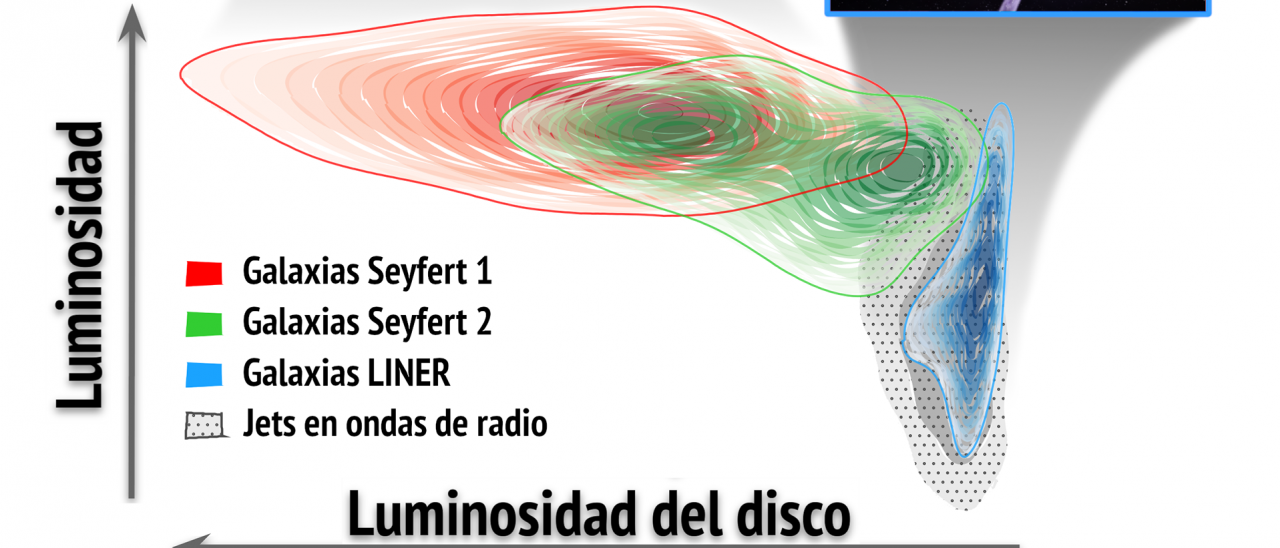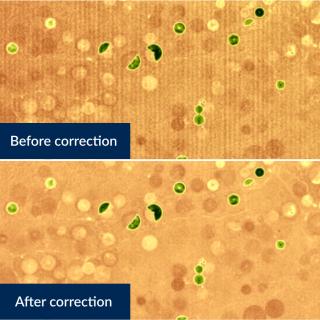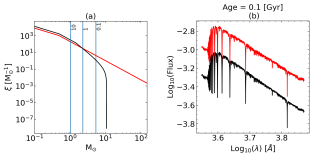The researchers Juan A. Fernández-Ontiveros, of the Istituto Nazionale di Astrofisica (INAF) in Rome and Teo Muñoz-Darias, of the Instituto de Astrofísica de Canarias (IAC), have written an article in which they describe the different states of activity of a large sample of supermassive black holes in the centres of galaxies. They have classified them using the behaviour of their closest “relations”, the stellar mass black holes in X-ray binaries. The article has just been published in the journal Monthly Notices of the Royal Astronomical Society (MNRAS).
Black holes range in mass from objects which have only a few times the mass of the sun up to those with thousands of millions of solar masses. To understand their activity cycles from a global perspective has been the object of research for decades. Those of stellar mass are found in binary systems together with a companion star from which they suck out the gas which they need to sustain their activity, while the supermassive variety are found in the centres of the majority of galaxies and they feed on the gas, dust, and stars which are fall into the gravitational well of the galactic nucleus.
Stellar mass black holes evolve rapidly. Their activity cycles usually last a few months or years, during which they pass through different states, or phases. These are characterized by changes in the properties of their accretion discs (where the hot gas accumulates before falling into the black hole), their winds, and the jets of material which they produce. There are two principal states, the first dominated by the accretion disc, and the second by the jet. The ‘soft’ state is noted by the thermal emission by the plasma of the disc, while the jet is observed in the ‘hard’ state, when the disc cools down, and the emission at radio wavelengths becomes very intense.
Because they are much more massive, the supermassive black holes evolve much more slowly than their stellar mass equivalents. So, to show the presence of states and transitory phenomena in these would imply observing them for millions of years, because the changes during a human lifetime would be too small to measure. In addition, the nuclei of galaxies are regions with dense populations of stars, and the absorption of light by hydrogen and dust masks and hides the radiation from the accretion disc around the central black hole.
In this study Fernández-Ontiveros and Muñoz-Darias have used a sample of 167 active galaxies to be able to identify the possible accretions states of supermassive black holes with good statistics. The emission from the accretion disc cannot be detected directly, but the gas in the central region absorbs and processes the radiation in the form of spectral lines. Using the lines of oxygen and neon, which are observed in the mid-infrared, it is possible to test the presence of the disc in these object. “The study demonstrates the presence of accretion states in supermassive black holes, with properties very similar to those we know from stellar mass black holes, where the systems in the ‘soft’ state harbour a bright disc, and those in the ‘hard’ state show intense radio emission while the disc is very weak”, explains Juan A. Fernández-Ontiveros, an INAF researcher who was trained at the IAC.
“This work opens a new window to understand the behaviour of material (gas) when it falls into black holes with a wide range of masses, and helps a more precise understanding of the activity cycles of the supermassive black holes which are in the centres of most galaxies”, adds Teo Muñoz-Darias, a researcher at the IAC.
The figure illustrates how the population of active Seyfert-1 galaxies is typically dominated by the emission of the accretion disk ('soft' state), while the population of LINERs is much less luminous and is dominated by jets ('hard' state), which emit intensely in radio waves. The Seyfert-2 galaxies, on the other hand, do not show a homogeneous behaviour and while a good part behave in a similar way to the Seyfert-1, a large group of them are located in intermediate states. The latter are also observed in stellar black holes for short periods of time.
Article: Juan A. Fernández-Ontiveros & Teo Muñoz-Darias, "X-ray binary accretion states in Active Galactic Nuclei? Sensing the accretion disc of supermassive black holes with mid-infrared nebular lines". Monthly Notices of the Royal Astronomical Society, april 2021. DOI: https://doi.org/10.1093/mnras/stab1108
- Prepress: https://arxiv.org/abs/2104.09538
Contact:
- Juan A. Fernández Ontiveros: j.a.fernandez.ontiveros [at] gmail.com (j[dot]a[dot]fernandez[dot]ontiveros[at]gmail[dot]com)
- Teo Muñoz Darias: tmd.astronomy [at] gmail.com (tmd[dot]astronomy[at]gmail[dot]com)



